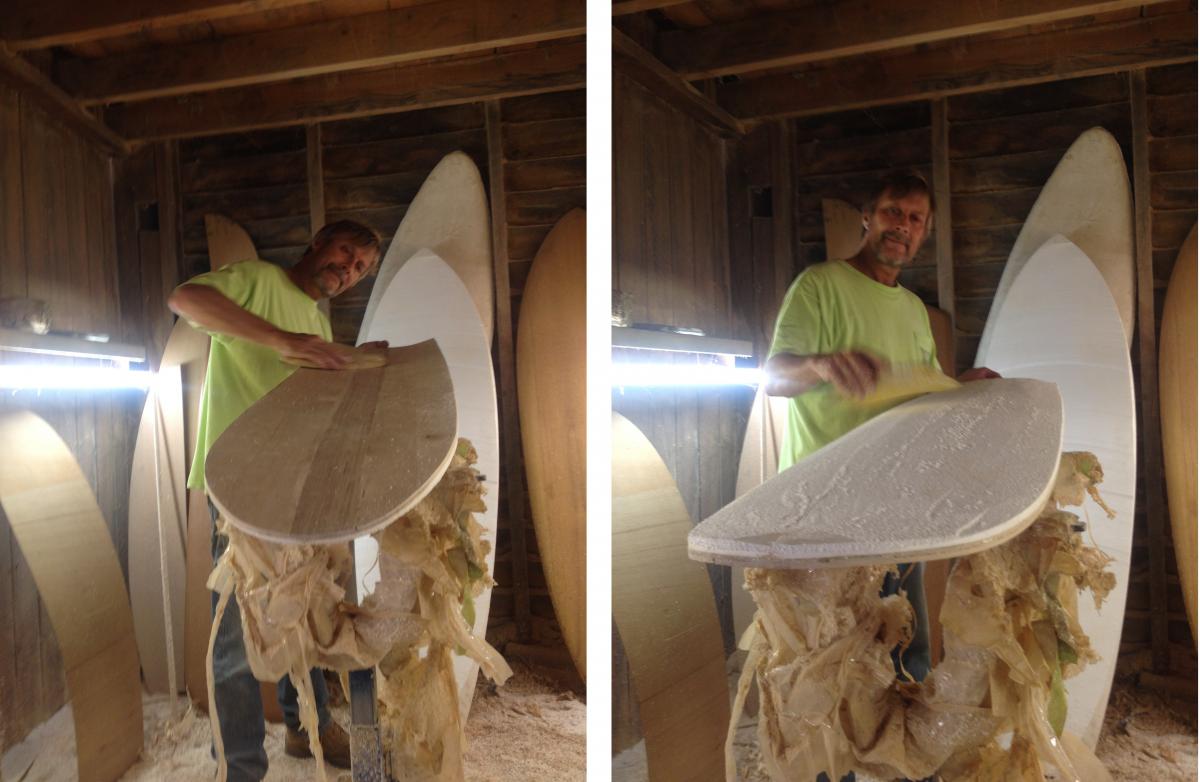
Corky quiver with JJ Star: From Left to right; JJ's body board, Finley;s 7'2 alaia style, my 5'6 tuna, 4'6 thin bellyboard and Carlos de Landre's board - the shape needs a name.
Top: Sean Cusik holds the tuna shape which is very similar to an albacore shape. I am holding a longer thinner board which is more like an alaia. JJ is holding a UK inspired belly board with concave through the bottom and a lifted nose. JJ's boogie board shape has a light concave going from rail to rail as well as 5mm of revers rocker through the middle. Carl's board leaning against me has a slightly rolled bottom from rail to rail and a very flat rocker through the center. All the boards have a fresh layer of linseed oil rubbed into the bottom and are super slick when moving through the water. Bottom: Sean takes off on the 7'2. Although this board has no rocker, the board flexes into the wave face lifting the nose out of the water. The board almost never pearls, however, without the flex it would be a pearling machine.
Top: JJ gets an absolutely astonishing amount of speed from his body board! I could not believe he was taking off on these small, average waves and still be able to blast top turns. The speed comes from the reverse rocker on the bottom and wide concave - as well as the oiled wood surface. Sorry the photo on the bottom is not framed well. I cannot believe that after all my years behind a camera, I can still stuff up shot after shot.
The biggest surprise of the day was how well Carl's board surfed! with round rails and a rolled bottom, I thought it would not hold an edge while going across the wave. I was wrong! It seems the flex through the board and especially along the rail grabs water and holds the board in. The super slick bottom does not affect the way the board grabs water, yet the board is noticeably faster with an oiled surface. Carl De Landre came to the Noosa Festival of Surfing this year for the finless division. Afterwards he spent a few days at my house and we started on a replica of his favorite finless board. It was an mini-mal which had the tail and the nose broken off and the ends crudely (sorry Carl) shaped and glassed. However, the board rips. Carl surfed it convincingly. Shapers are sometimes humbled to find super beat up and broken boards surf better than the new boards we produce.
Top: After watching Sean and JJ on Carl's board, I had to feel what whas going on. I can feel finless boards better when bellyboarding. I can feel how the rails and curves are engaging with the water. I was suprised by how easy the board was to ride. I had no issues with side slipping without any hope of control. Side slipping, or the "La La" as ancient Hawaiians called it, is great fun, however, you want to be able to gain control again. Bottom: My happy place on the thin bellyboard. This board is very flexible - Even more flexible than a 10mm thick surfie. The bottom on this board has two layers of 4mm paulownia sheets, 10mm of EPS foam and then 6mm of cork sheeting. this makes for a fast, flexible buoyant bellyboard. It is very easy to flex the board into the wave face and get perfect placement under the lip.

I am shaping the thin, UK inspired bellyboard. I am making this board for a surfie enthusiest who wants to put fins on and kick into bigger waves. I made it with two sheets of paulownia which are at slight angles to eachother so they will not crack. I put concave in the bottom because this makes in much easier to plane on the water when kicking onto a wave. (When I measure all the properlly ancient alaia's in the Bishop Museum they all had concaves). The thin layer of EPS foam and then the cork makes for a suprisingly buoyant board!
With my new "Corky" system I can make custom shapes. If you ever wanted a certain flex, I bet I can make it. Cheers, Tom